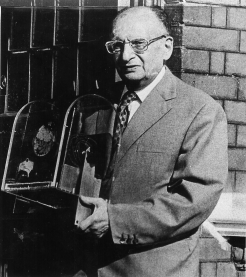Paul Eisler facts for kids
Quick facts for kids
Paul Eisler
|
|
|---|---|

Paul Eisler with the first radio set using a printed circuit chassis and aerial coil. (Photo: Maurice Hubert, Multitech UK)
|
|
| Born | 1907 Vienna, Austria
|
| Died | 26 October 1992 (85 years) |
| Nationality | Austrian |
| Alma mater | Vienna University of Technology |
| Scientific career | |
| Fields | Electrical engineering |
| Institutions | Technograph |
Paul Eisler (1907 – 26 October 1992) was a clever inventor from Vienna, Austria. He is best known for inventing the printed circuit board. This invention is super important because it's used in almost all electronic devices today, like phones, computers, and TVs! In 2012, a magazine called Printed Circuit Design & Fab honored him by naming its Hall of Fame after him.
Early Life and Learning
Paul Eisler finished his engineering studies at the Vienna University of Technology in 1930. Because he was Jewish, he faced unfair treatment and couldn't find an engineering job in Vienna. So, he moved to Belgrade to work for an English music company called Gramaphone Company (later known as EMI).
His job there was to stop radio static on music systems in trains. The project worked well, but the company couldn't get paid in money. They were paid in grain instead, which wasn't helpful. Because of this, Paul had to go back to Vienna.
He still couldn't work as an engineer, so he became a journalist and printer. This experience with printing turned out to be very useful later on! He worked for a newspaper that was later shut down. After this, he used some of his ideas from university to get a special pass to visit England in 1936. He hoped to sell his inventions there. While in England, he helped his cousin's father escape from a very bad place called the Dachau concentration camp.
Amazing Inventions
When Paul Eisler first arrived in Hampstead, England, he didn't have a job or permission to work. He started building a radio using his idea for a printed circuit board. At the same time, he tried to sell his other inventions.
He also worked for a movie theater company called Odeon. People often spilled food like ice cream on the seats. Paul came up with a smart idea: he designed a yellow fabric cover for the dirty seats. This helped the next person avoid the mess and showed staff which seats needed cleaning.
During World War II, Paul was held by the British government for a short time because he was from Austria, which was an "enemy country" at the time. After he was released in 1941, he found a company called Henderson and Spalding. They agreed to invest in his printed circuit idea through a new company called Technograph. Paul signed a contract that gave him some ownership of Technograph, but it also meant the company owned the rights to his invention.
His printed circuit technology didn't get much attention until the United States started using it for a special device called a proximity fuze. This device was very important for stopping German V-1 flying bombs during the war. Paul was able to get three patents for his printed circuit ideas in 1950.
After the war, the United States shared his printed circuit invention with others. Since 1948, it has been used in almost all airplane electronics. However, not many companies paid Technograph to use Paul's patents, and the company faced money problems. Paul left Technograph in 1957.
As a freelance inventor, he worked on new ways to heat things. He created special films to heat "floor and wall coverings" and even food, like fish fingers. His idea for heated wallpaper was good, but people lost interest when cheaper energy sources, like natural gas from the North Sea, became available.
Paul Eisler also invented other useful heating devices, such as a pizza warmer and a defroster for car rear windows. However, these inventions were not very successful in the market.
Awards and Recognition
Paul Eisler received several important awards for his work. The French government gave him the Pour le Mérite award. The Institute of Electrical Engineers also honored him with the Nuffield Silver medal.
See also
 In Spanish: Paul Eisler para niños
In Spanish: Paul Eisler para niños

